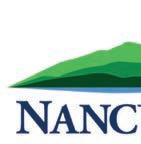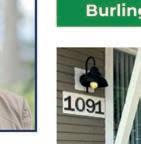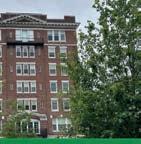House bid
Burkhardt announces run for Legislature
Page 2



House bid
Burkhardt announces run for Legislature
Page 2


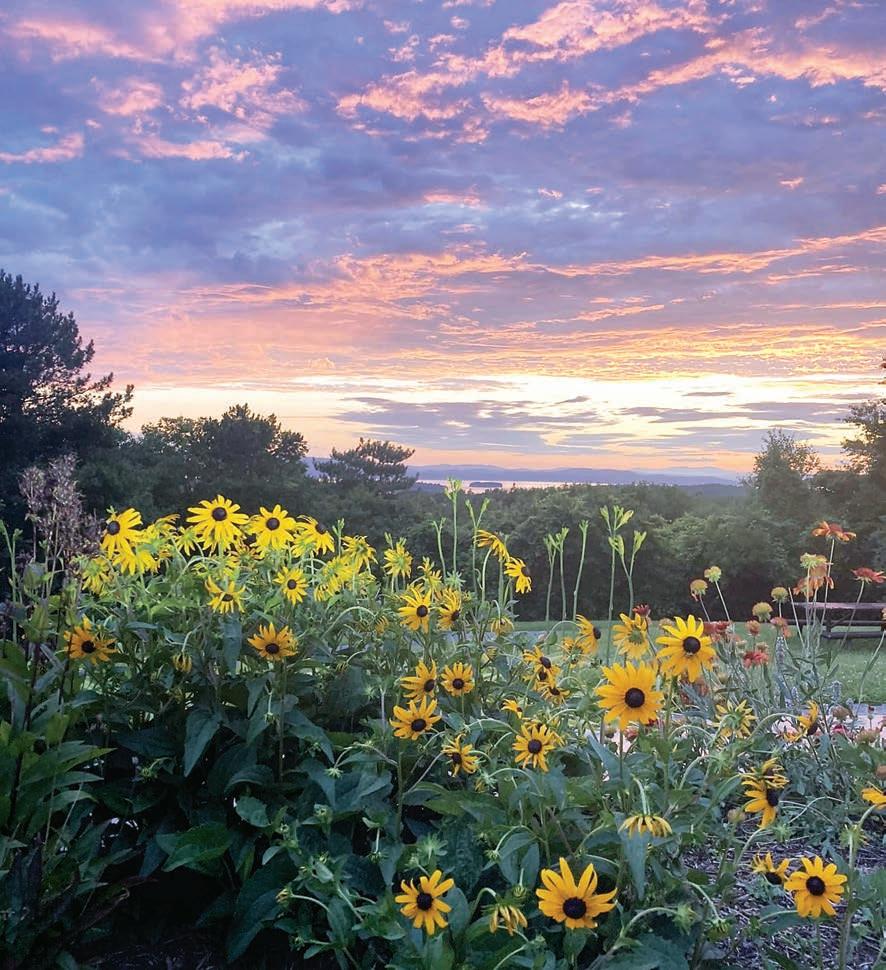
LIBERTY DARR STAFF WRITER
What does the future of farming in Vermont look like?
For a group of four prominent farmers in South Burlington and Shelburne — Bread and Butter Farm, Killeen Crossroads Farm, Blank Page Café and Chrysalis Landworks — a future might only be possible by working together.
Through a new nonprofit known as The Agrihood Collective, these farmers are exploring
solutions to the ever-growing challenges of working in agriculture and are collaborating on an innovative land-ownership model in partnership with the Vermont Land Trust.
And now, plans are coming to fruition as the group moves through fundraising to purchase nearly 360 acres of land in South Burlington to support its agricultural dreams to build a comprehensive shared-
See FARMING on page 11
LIBERTY DARR STAFF WRITER
A years-long battle over relocating Higher Ground, the state’s largest live music and entertainment venue, from South Burlington to the Burton campus in Burlington’s South End may have finally ended last week after the Vermont Supreme Court rejected an appeal from residents who opposed the move.


Project plans include converting an 11,560-square-foot portion of a warehouse building owned by Burton next to the company’s head-
See HIGHER GROUND on page 13
Last Friday, after nearly two months of deliberation, the Supreme Court reaffirmed that the permit granted by the city and a state Act 250 permit were properly issued, moving the project five years in the making closer to the finish line.




Political Notebook
Bridget Burkhardt
My name is Bridget Burkhardt, and I am running as a Democrat to represent Chittenden-8 in the Vermont House of Representatives.
My family and I moved to South Burlington in 2010 and have been grateful for this wonderful community for the past 14 years. After the first chapter of my finance career, which included roles in investment banking, private equity and community development finance, followed by several years as a stay-at-home mom, I was inspired to try to give something back to the community by running for the South Burlington School Board.
My South Burlington neighbors elected me to three terms on the board, and I served from 20162022, eventually becoming chair of the board. In 2022 I stepped down from the board and returned to the private sector to work as a portfolio manager for a community development private equity fund where I have supported and advised portfolio companies in the health care and addiction treatment sectors.
During my years on the school board, I saw firsthand how decisions in Montpelier impact local communities and had a window into a broad range of challenges faced by Vermonters. The board’s work focused directly on educational issues — the need for improved learning outcomes across a broader range of students, students’ rapidly growing needs for mental health, special education and social services, the impact of growing diversity in our schools and aging school infrastructure, to name just a few. However, as board members we also saw how a lack of affordable housing, the opioid crisis, food insecurity, domestic violence, discrimination
The grand list in South Burlington grew $136 million last year, not $1.4 million as reported last week.
The people depicted in the photo accompanying the story, “Meet the faith guided leaders backing South Burlington’s food shelf,” were student volunteers from South Burlington High School.
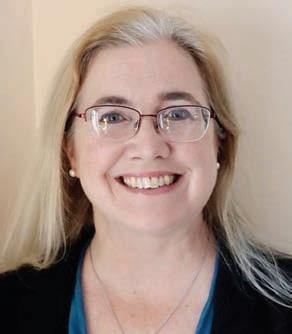
and many broader issues affect our children.
Some of the issues that drove me to run for the Legislature include:
• Education: As a district we tried to meet children’s expanding needs while facing growing costs, particularly rapidly rising health care premiums and the need to keep taxes under control. This work was complicated by a complex and changing school funding formula that made it difficult to create budgets and communicate about the impact of them effectively with voters. We need to reshape the way we fund education in Vermont to provide more predictability for districts and taxpayers. Without dictating curriculum from the state level, we need to find ways that we can support improved learning outcomes for children from all backgrounds. We must find a way to fund the necessary improvements to and, in some cases, replacement of aging school facilities.
potential negative impact of housing development on the environment.
• Environment: We need to improve Vermont’s resilience in the face of climate change. We need to continue to devote resources to cleaning up our waterways that are impaired by pollution and invasive species. We need to preserve forests and agricultural land for future generations.
• Economic development: We should support innovative companies and entrepreneurs that can bring jobs to Vermont and allow our children to chart a future for themselves here. We need to support public education and technical programs that will ensure these businesses have the skilled workforce they need to grow. We need thoughtful regulation that can provide incentives to the types of businesses that can thrive in Vermont while respecting and preserving the environment and the qualities that make Vermont unique.
We need creative solutions that will allow us to increase the availability of housing while minimizing the potential negative impact of housing development on the environment.
To be an effective legislator, I believe one needs to be able to process a large amount of information about a wide range of topics to understand the challenges facing constituents and assess the potential impact of proposed solutions. A good legislator should also be able to combine empathy for people from a range of backgrounds with an understanding of data and financial information to help set priorities and make tough decisions about how to allocate limited resources.
• Affordable housing: We need to ensure that all Vermonters have access to safe, stable, affordable housing. We need to make sure that seniors can age in place if they choose to do so and that children have a path to homeownership as they reach adulthood. We must make sure that there is enough housing so that prospective employees of growing businesses who want to move to Vermont can find a place to live. We need creative solutions that will allow us to increase the availability of housing while minimizing the
Most of all, I think a great legislator must be willing to solicit a wide range of viewpoints from constituents and use that information to help guide their work. I believe that my school board service and my private sector finance work experience have given me a strong foundation and the tools to be an effective legislator on behalf of the residents of southeast South Burlington and southwest Williston. I hope to connect with as many of you as possible over the next few months to hear your concerns, gather your input and earn your vote.
Feel free to reach out to me at burkhardtforvt@gmail.com.
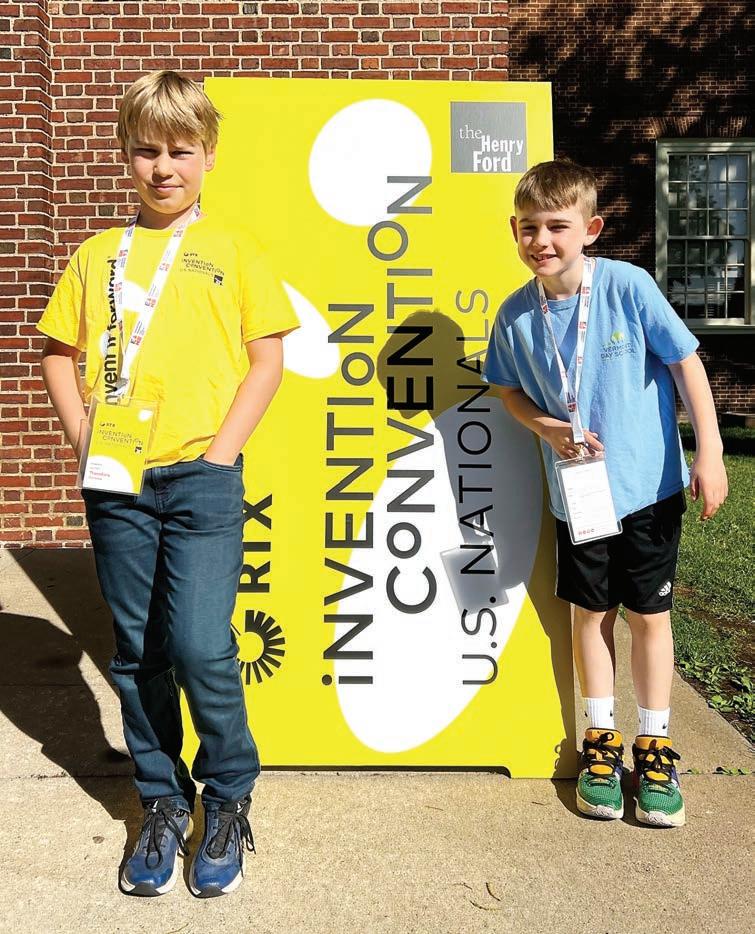
In June, three Vermont Day School students traveled to the Henry Ford Museum of American Innovation in Dearborn, Mich. for the U.S. National Invention Convention.
Shannon Capps (first grade), Whitaker Newton (third grade) and Theo Gonyaw (fifth grade) were each top finishers at the Vermont Invention Fair last February.
At the national fair, each inventor showcased their invention to the public and presented their idea to a team of judges. The inventions included a book puller offer by Capps, hello ring by Newton and backyard farmer and egg collector by Gonyaw.
All three participated in the school’s Invention Club where they identified a real-world problem, conducted research, developed protypes, tested and refined ideas and practiced presentation skills.
Taking part in the invention process
was an invaluable learning opportunity noted parent Amy Gonyaw.
“My child learned there’s a lot of trial and error in coming up with an idea that’s worth developing. He learned that there are inventions to be made around him, he just needs to keep looking for them,” she said. “Approaching life with a creative, problem-solving mindset will serve him well no matter what he chooses to do.”
The next Vermont Invention Fair will take place in February 2025 at Vermont Day School in Shelburne. The Vermont Fair is open to all K-8 students in Vermont and is made possible through the school’s partnership with the Young Inventors’ Program at the University of New Hampshire’s Leitzel Center.
Interested participants should visit vtdayschool.org for registration information.









MIKE DONOGHUE
CORRESPONDENT
A Chittenden County drug dealer, whose operation was broken up during a raid at a South Burlington hotel in 2022, has been sentenced to 15 years in federal prison.
Melvin K. Hill, 45, was convicted on five felony drug and gun charges by a jury in U.S. District Court in Rutland last summer.
Hill often operated his drug trafficking business out of South Burlington-area motels, including the DoubleTree Hotel at 870 Williston Road, where he was arrested in March 2022, the U.S. Drug Enforcement Administration said.
The Drug Enforcement
Administration said investigators during court-ordered searches of his car and hotel room found Hill carrying about an ounce of crack cocaine, three cellphones and a loaded Taurus .40-caliber pistol with eight rounds in the magazine.
The DEA also seized hundreds of folds of fentanyl, hundreds of pills containing near-pure methamphetamine and some powder cocaine from his hotel room and his silver Mazda. They also confiscated narcotics paraphernalia and about $13,000 in cash, including funds used by an informant in one drug buy.
During sentencing last week, Chief Federal Judge Geoffrey W. Crawford said Hill will be under federal supervised release terms for 10 years once he is freed from prison. He will get credit for the
South Burlington’s Community Newspaper Since 1977
A publication of Vermont Community Newspaper Group LLC otherpapersbvt.com
Advertising Director
Judy Kearns judy@otherpapersbvt.com (802) 864-6670 x21
Advertising Wendy Ewing wendy@shelburnenews.com (802) 985-3091 x12
News Editor
Tommy Gardner
Staff Writers
Aaron Calvin Liberty Darr
Production Manager
Stephanie Manning stephanie@shelburnenews.com
Editor/Publisher
Gregory Popa gpopa@stowereporter.com
Billing inquiries Leslie Lafountain leslie@stowereporter.com (802) 253-2101
Advertising submission deadline: Thursday at 5 p.m.
advertising@otherpapersbvt.com classifieds@otherpapersbvt.com
Editorial submission deadline: Friday at 5 p.m. news@otherpapersbvt.com
Calendar submission deadline: Friday at 12 p.m. news@otherpapersbvt.com
Contact: 1340 Williston Road
South Burlington, VT 05403 (802) 864-6670
The Other Paper is published weekly and mailed free to South Burlington residents and businesses, and rack distributed in select high-traffic areas. The Vermont Community Newspaper Group LLC assumes no responsibility for typographical errors in advertisements and reserves the right to refuse advertising and editorial copy.
just over two years that he has been detained.
Hill, originally from the state of Georgia, has at least five previous drug convictions, including a trafficking case in 2012 in federal court in Vermont.
Hill fired a few lawyers during the case, including one on the eve of trial. Hill defended himself and the jury took less than an hour to convict him.
from federal prison and is likely to return to Vermont to peddle the drugs “because he knows the top dollar price drugs command in this state.”
“Hill expressed no remorse for his drugdealing or weapons possession. Indeed, he suggested as a veteran, he had a constitutional right to bear arms.”
The court appointed South Burlington lawyer Karen Shingler to help with his sentencing. Shingler raised several issues and asked that Hill receive only the 10-year mandatory minimum.
— Gregory Waples
But Assistant U.S. Attorney Gregory Waples said the government fears Hill will revert to drug dealing when he is freed
Waples also rejected a claim by Hill that he had accepted responsibility for his actions.
“This is wishful thinking,” Waples said in his sentencing memo. He wrote that the government was forced to prove all the crimes at trial.
“Hill expressed no remorse for his drug-dealing or weapons possession. Indeed, he suggested as a veteran, he had a constitutional right to bear arms.”
Waples said Hill also contended that his crimes were “victimless.”
The case began when an infor-
mant came to Burlington police in January 2022 and said she was aware of a man selling methamphetamines, heroin and fentanyl and crack cocaine in the area, the DEA said.
The jury convicted Hill for fentanyl sales and for possession of four kinds of controlled substances (fentanyl, crack cocaine, powder cocaine and methamphetamine) with intent to distribute each.
Jurors also found Hill guilty of two gun charges: illegal possession of the .40-caliber pistol and a Glock .45-caliber pistol, because he was a 5-time convicted felon.
Hill, who was on parole for a drug case in Georgia, arrived in Vermont in December 2011 to work for his brother, but soon became part of his interstate crack cocaine conspiracy that netted six arrests, records show.
In his earlier federal case in Vermont, Hill sold drugs from South Burlington hotels, including the Anchorage Inn, the Ho Hum Motel and the Quality Inn, where he was arrested in May 2012, records show.
Total incidents: 214
Agency / public assists: 21
Directed patrol: 5
Traffic stop: 20
Accident: property damage: 12
Alarm: 10
Field contact: 8
Foot patrol: 11
Suspicious event: 14
Retail theft: 5
Trespass: 7
Animal problem: 4
Motor vehicle complaint: 15
Welfare check: 15
911 hangup: 4
Domestic: 5
Fraud: 5
Disturbance: 4
Operations patrol: 3
Paperwork service: 4
Threats: 3
Accident:
insurance purposes: 3
Sex crime: 2
Unlawful mischief: 2
Larceny from a vehicle: 4
Larceny from a structure: 2

Arrests: A 14-year-old, no address provided, was arrested on three instances of disorderly conduct and weapons possession or use of slung shot, blackjack or brass knuckles on June 5 at 3:51 p.m. on Dorset Street.
July 6 at 11:01 p.m., Jacob A. Dougher, 31, of Burlington, was arrested for disorderly conduct and felony unlawful mischief on Williston Road.
July 8 at 10:48 a.m., Nicole M. Laplante, 34, of Essex, was arrested on an in-state warrant on Williston Road.
July 9 at 8:41 a.m., Lisa M. Gosselin, 56, of Colchester, was arrested for resisting arrest, cruelty to animals, unlawful trespass and disorderly conduct on Shelburne Road.
July 11 at 6:08 p.m., Brian Charles Foy, 48, no address given, was arrested on an in-state warrant
at Shelburne Road and Imperial Drive.
July 12 at 8:19 a.m., a 16-yearold, on address provided, was arrested for negligent operation on National Guard Avenue and NCO Drive.
July 13 at 10:25 a.m., Jessica K. Gagnon, 44, no address provided, was arrested for felony possession of stolen property on Farrell Street.
Untimely deaths:
July 13 at 11:37 a.m., police responded to South Beach Road for the death of Marcia Derosia, 72, of South Burlington. The medical examiner’s office is determining cause and manner of death.
Note: Charges filed by police are subject to review by the Chittenden County State’s Attorney Office and can be amended or dropped.
Local businesses employ people who are customers of other local shops, restaurants, printers, accountants, farms, attorneys, etc. ... Maybe even yours.

Guest Perspective
Don Tinney
No political insiders in Montpelier were surprised when Sen. Jane Kitchel condemned the Scott administration’s proposal to zero out the education fund reserves to provide short-term property tax relief, saying “that is a practice that we never ever had considered, or would consider, as fiscally responsible use of a reserve.”
In her long, distinguished career as a political leader, Kitchel has always been fiscally responsible while working diligently to meet the human needs of Vermonters, so no one was surprised when she voted to override the governor’s veto of the education funding bill. She
had the political courage to do the right thing to protect Vermont’s public education system and to provide services to Vermont’s most precious resource, our children.
Every legislator struggled with the education funding bill. They knew it would be an unpopular decision that would lead to increased property taxes, yet voted to support public schools, the cornerstone of democracy. Legislators who voted to support the children and youth of Vermont demonstrated true political courage. They chose to support sound public policy and fiscal responsibility without regard for their own political popularity.
Ever since Ronald Reagan entered American politics, Republican politicians have generated
Guest Perspective
Ben Kinsley
Don Tinney’s hit piece on Gov. Phil Scott is nothing new for the VT-NEA, although I’m surprised by the shrillness of his tone. Perhaps he realizes how much Vermonters have lost patience with rising property taxes and declining outcomes and is hoping to deflect attention away from his organization. (See guest perspective above.)
The basic facts are that we have more adults per student in our schools than any state in the country — and it’s not even close — resulting in the second highest cost per student.
Over the past decades, we have seen steady spending increases, driven by staffing levels that have persisted despite Act 46. Further, and more alarming, test scores have declined compared to other states that spend less and have larger at-risk student populations.
political popularity by promising tax cuts. Grover Norquist founded the Americans for Tax Reform in 1985 and has been one of the chief architects of the current GOP’s dogma of reducing taxes and shrinking the size of government.
Former Republican Sen. Alan Simpson of Wyoming was particularly critical in describing Norquist’s position as “no taxes, under any situation, even if your country goes to hell.”
This anti-tax mentality led to the 2017 Trump tax law which cost the government $1.9 trillion in revenues and failed to deliver any economic benefits to average Americans.
On June 17, we heard this Republican anti-government stance articulated by Republican Rep. Patricia McCoy of Rutland County speaking against the education funding bill that would provide adequate resources for public education.
“This bill continues to feed the beast,” said McCoy, who is House Minority Leader.
Vermonters know the importance of public education in meeting the needs of our children and youth and do not see our schools and the students they serve as any type of beast.
tenant governor for six and a state senator for 10 — and offer no plan to find the necessary revenues to support an education system that meets the needs of young Vermonters and their families.
No new taxes is neither a plan nor effective public policy.
We can see from the National Center for Education Statistics data that in the early 2000s we were spending below our peers in New England but achieving better results. By 2015, their eighth-grade math outcomes had surpassed ours despite our spending growing at nearly twice the rate — 61 percent versus 37 percent. Test scores have been trending downward across the board over the past decade, however Vermont’s scores are declining much faster than the nation at 5.9 percent compared to 3.4 percent.
This trend is similar when looking at other disciplines and grade levels and the trend is continuing despite a sharp increase in spending since the 2018-2019 school year. Today, we are spending nearly 79 percent more than the national average but getting
Vermont’s current governor follows Norquist’s simplistic directive in his refusal to increase revenues to support essential services to Vermonters. He knows that one way to remain popular is to continue to rail against taxes. It’s a winning formula since no one wants to pay higher taxes. While “no new taxes” is a popular campaign slogan, it does nothing to improve public policy and ensure services for Vermonters, and it certainly doesn’t display an ounce of political courage. The only thing this affordability argument does is fuel the anti-government attitude and rhetoric on social media and at Trump rallies.
On that same day, Republican Rep. Michael Morgan of Milton, said, “My constituents, as a whole, have reached out begging for relief in this arena. Why we are not working to find a solution for relief now is beyond my comprehension.”
Perhaps Morgan’s Statehouse colleagues could help him comprehend how they worked during the entire legislative session to find a solution and how the governor’s proposal was so fiscally irresponsible that it was panned by Wall Street. While that might be beyond his comprehension, many Vermonters cannot comprehend how a Republican can be in the governor’s office for eight years — after being lieu-
Vermonters have made it abundantly clear that they want a new equitable education funding system. Thousands of citizens voted against school budgets this year who had never considered voting against a school budget in the past, but were voting against severe property tax increases, not against their local school budgets.
Since 2018, Vermont-NEA has argued that Vermont must shift education financing from property tax to income tax, allowing all Vermonters to pay their fair share. Rather than blaming Democrats and calling them arrogant, perhaps the governor can find the political courage to let go of his Norquist pledge card, roll up his sleeves and work with the legislators who were voted into office by the same Vermonters who voted him into office, and build a strong and effective state government. That will take real political courage.
Don Tinney, a longtime high school English teacher, is president of the Vermont-NEA.


Through a combination of demonstrations, vignettes, narrated boat cruises and battle reenactments, visitors will experience the British advance for Lake George as Fort Ticonderoga presents the 1759 Siege of Carillon two-day battle reenactment Saturday and Sunday, July 20-21.
Become immersed in this 18th-century siege featuring the constant roar of cannon, battle reenactments and even a nighttime program where visitors are immersed in the battle for Carillon, named Ticonderoga by the British once they captured the fort from the French.
The reenactment will take place all weekend and is included as part of daily admission.
The weekend starts Saturday with “The Calm Before the Storm” as visitors step into Fort Carillon on July 23, 1759, and discover how the French to block British invasion on Lake Champlain.
Visitors will discover Gen. Jeffrey Amherst’s plan to prevent the mistakes of 1758 as he advanced toward Ticonderoga with his 11,000-man army of British and American provincial soldiers. Watch as British regulars, American provincials, rangers and Native American warriors push from Lake George to capture the Heights of Carillon. See how French soldiers traded ground for time, as they carefully stalled the British advance in preparation to defend Fort Carillon.
Later that day, during an evening program, the twilight will be ablaze with gunfire as visitors experience the 1759 Siege of Carillon based on original eyewitness accounts on both sides of the lines.
See the British and American provincial soldiers continue to dig their cannon batteries and guard their position even as mortar bombs fall along with the darkness.
On Sunday, Explore the last hours of Fort Carillon, as the French prepared to evacuate, even as they continued to fire at the encircling in “The Aftermath.”
French soldiers sortie out from Fort Caril-
‘Broadway in Vermont’

lon one last time to disrupt British progress on their entrenchments and cannon batteries.
After initially faltering from the surprise, British and American provincial soldiers regain their position, and the work of the siege continues. Get the rare sight of the French evacuating by bateau on Lake Champlain.
Advance tickets are encouraged at fortticonderoga.org.

Foundation provides $25K for programming, other items
JOHN SIMSON CONTRIBUTOR
July 1 marked the first day of a new fiscal year for the reorganized South Burlington Library Foundation. New committees are at work to carry out its mission to raise, manage and grow funds for the library.
The current organization succeeds the Aspire campaign, which raised nearly $1 million to supplement the city budget for the new library building and fixtures. Now the foundation uses an annual fundraising campaign, special donations and grants to provide for the needs of the library not supported by the annual city budget.
Just like the Aspire campaign, the foundation relies on the generosity of the growing number of library patrons in the community.
Because of generous donors the South Burlington Library Foundation gave the library $24,500 last fiscal year. Among the items and programs that the foundation funded include book bags for the 2024 summer reading program, funding for the library’s Juneteenth programs, personal computers for the Teen Hangout room, a computer for the children’s library and, with a grant from The Community Foundation, the artist in residence program “My Vermont Eyes,” which brought Dr. Jolivette Anderson-
Douoning to the library for several events.
This year, we asked library director Jennifer Murray for a list of items she wanted to meet the needs of the library and requests from patrons not included in the city budget. That list includes additions to the book, eBook and audio collections. It adds library programs like adult and teen author visits, Juneteenth 2025, support for next summer’s reading program, and adult holiday food and music events.
Also included is new equipment to improve the enjoyment of patrons and important upgrades to the utility and appearance of key library areas. This list will offer a challenge to the foundation fundraisers, but we are confident we can count on the community’s support of its library.
Our donors have been stalwart in past years and the rising popularity of the library with groups and individuals of all ages and interests should inspire additional supporters to join in. If you would like regular updates from the foundation or to volunteer, go to southburlingtonlibraryfoundation.org and share your contact information.
John Simson is a director of the South Burlington Library Foundation, a 501(c) (3) nonprofit organization that raises and manages funds to support the South Burlington Public Library.
only marginally better results.
To be fair, Scott has offered few actionable policy suggestions to address this problem and the most coherent one was offered by the tax commissioner at the 11th hour of the legislative process. Tinney rightly criticizes the plan to borrow against reserves, which would simply create a larger financial hole to dig out of next year.
However, the VT-NEA and its friends in other education special interest groups have also offered little in the way of meaningful reform. Tinney points to an income tax as the solution to our woes but the reality is that two-thirds of Vermonters pay based on their income today. Replacing the third of taxpayers that pay based on the actual value of their homes would increase the volatility of education tax revenues (home values are more stable than incomes particularly for higher income households) and further exacerbate the property tax rollercoaster.
It is also concerning that he casts fiscal restraint as a partisan issue and attempts to tie Scott to Trump because he refuses to raise taxes. Vermonters know better than that. In fact, Sen. Jane Kitchell (D-Caledonia), who Tinney himself praises in his opening paragraphs, is known for steadily steering the ship of fiscal responsibility in the Senate. She even, as reported by VTDigger, opposed the Universal School Meals proposal in 2013 pushed by Tinney and his allies, which is now contributing to the current property tax crisis.
Tinney was right about one thing though. Vermonters have made it abundantly clear that they think the education funding system is broken. The problem is that the current system is so opaque it is not clear if increased taxes are the
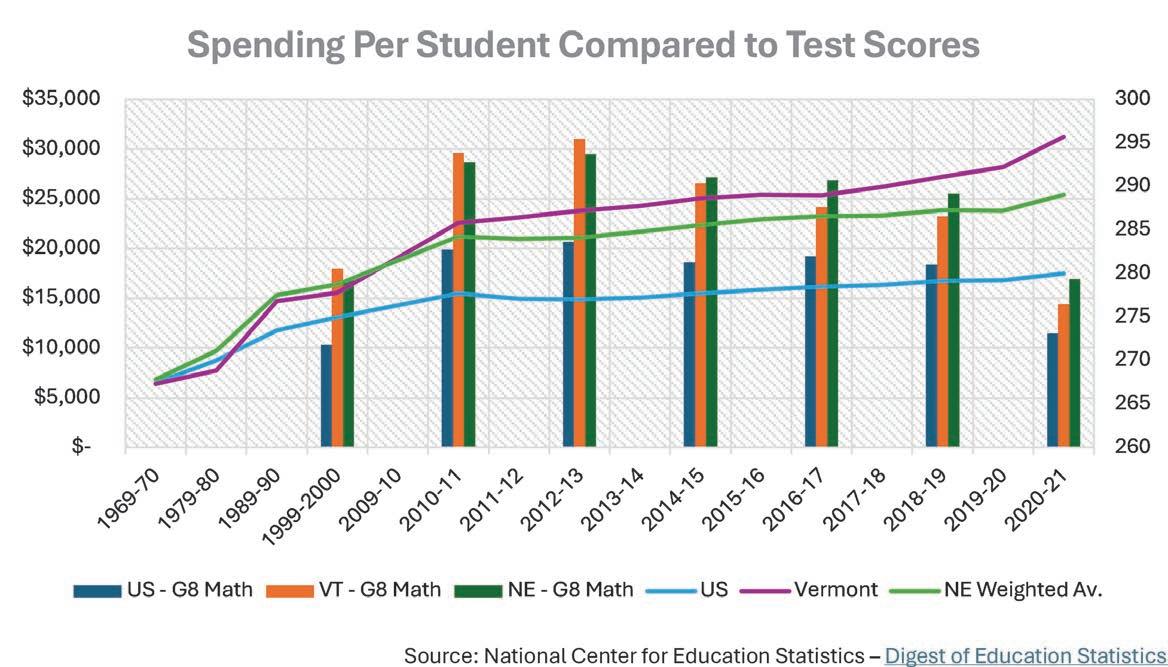
result of local spending, unfunded mandates or legislative taxing decisions.
That lack of transparency means that no one is held accountable and spending and property taxes both continue to increase unchecked year after year.
The Commission on the Future of Education that the Legislature went all-in on this session is made of up lobbyists for superintendents, principals, teachers and other special interests who helped to design the current system. I am not optimistic they will produce a different outcome this time around.
Ben Kinsley has over a decade of public policy experience in Vermont. Working for nonprofit organizations, he has worked




Rev. Dr. Anne Hartley has joined All Saints Episcopal Church as its new priest in charge.
Hartley comes from St. Thomas Episcopal Church in St. Petersburg, Fla., where she’s been responsible for celebrating Eucharist each week, and assisting with youth ministry, pastoral care and other outreach initiatives.
She holds a doctorate in biogeochemistry and was an assistant professor in terrestri-
al ecosystem ecology at Florida Gulf Coast University. Following her tenure there, she completed a Master of Divinity degree from General Seminary in New York City. She was ordained to the Episcopal priesthood in August 2022.
Hartley starts at All Saints on Aug. 1. She will also serve St. Paul’s Episcopal Church in Vergennes. She lives in South Burlington.
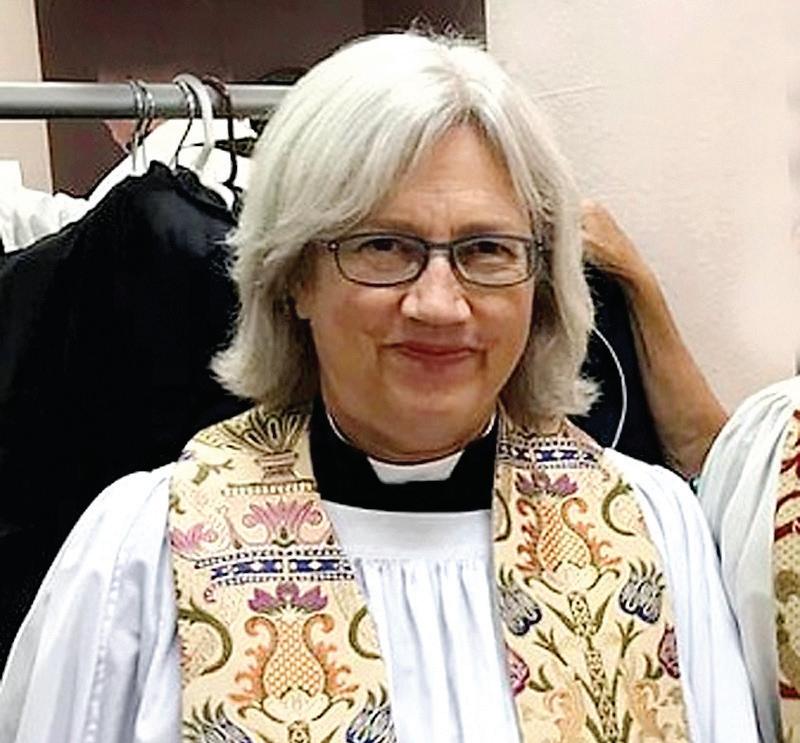

The Ethan Allen Homestead Museum offers a look back at the history of the health of Vermonters in the 19th century with the talk, “Substance Abuse and Abortion: Surviving Health Challenges in 19th Century Vermont” by Gary Shattuck, on Sunday, July 21, 2 p.m.
The presentation will discuss two of the most difficult challenges people faced during this time,
substance abuse and abortion, demonstrating that “the more things change, the more they stay the same.”
Admission is free but donations are appreciated.
Through Aug. 9, Monday to Friday, free summer meals will be provided to all children under 18 at Frederick H. Tuttle Middle School,
Chamberlin Elementary School and Rick Marcotte Central School. The meals must be consumed onsite. Breakfast is served from 7:308:30 a.m. and lunch goes from 11:30 a.m.-12:30 p.m. There will be no meals on July 4 and 5. There’s no application or paperwork necessary. Meals are free for all children 18 and under. See the menus at sbschools.net/ summermeals.
Williston and Georgia South I-89 Welcome Centers - $17.15/hr
e Williston and Georgia South I-89 Welcome Centers are looking to hire full-time, part-time and/or per diem employees with great customer service skills and a love for Vermont tourism.
Duties include some custodial tasks and physical tasks including snow removal. Weekend and some holiday availability is required.
To learn more or to apply, email welcomecenters@vermont.org

Nathalie E. Lovett, of Shelburne, was reunited with her beloved husband Bill, on Wednesday, July 3, 2024, one day shy of her 97th birthday.
Nathalie was predeceased by her husband, William “Bill” Lovett, in March 2022.
She is survived by her six children, Madonna Repeta of Bedford, N.H., Mark Lovett of Jackson, Wyo., Melissa Grasz of Hull, Mass., Jude Melen of Shelburne and Pamela Lovett and Valerie Lovett, both of
South Burlington. She is also survived by 10 grandchildren and six great grandchildren. There will be no calling hours. A Catholic Mass celebrating Nathalie’s life and faith will be held on Friday Aug. 16, 2024, at St. Catherine of Siena Church in Shelburne at 2 p.m
In lieu of flowers, please consider donating to the Alzheimer’s Association as in the end this disease is what took Nathalie from her family. For full obituary visit gregorycremation.com.
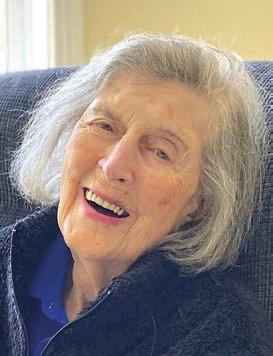

continued from page 8
Hospital board hosts community conversation
The Vermont Green Mountain Care Board hosts a discussion on the future of health care in Vermont on Monday, July 29, 4:30-6 p.m., at the South Burlington Public Library.
Despite rising insurance costs, Vermont’s hospitals and health systems face financial pressures and the health system requires revitalization, organizers say. Join local community leaders, hospital leaders, legislators, state officials and neighbors in discussing the options your community has for supporting the future of health care in Vermont.
Learn more at gmcboard. vermont.gov/act-167-community -meetings.




Clean & Green
Donna Leban
My friend Susan really enjoys her commute most days, even if she sometimes needs to make a mad dash down her neighborhood road to catch her ride. Susan is part of a growing trend for commuters using buses and smaller commuter vans instead of a personal vehicle and she has been doing so since summer 2018.
According to Susan, who doesn’t have daily access to the family car, it’s also convenient and enjoyable. Her fellow Tri-Valley Transit bus riders and regular bus driver, Bonnie-with-a-B, are quite friendly, exchanging stories and advice as they’ve gotten to know each other. Some commutes are livelier than others and baked goods are offered up on occasion from one of the riders, according to Susan.
Other days are more contemplative, with riders deep in thought as they enjoy the scenery, catch up on a book or work on a knitting or crocheting project.
Arriving on a set schedule, even with a fill-in bus driver, the transit van drivers work hard to show up on time every day. Riders therefore develop excellent skills such as being attentive to the clock and when that fails, sprinting to meet the bus. The extended van vehicles used for commuter routes are a lot more comfortable than the bouncy-suspension school buses many of us rode for years.
The 116 Commuter, operated jointly by Green Mountain Transit and Tri-Valley Transit currently has two of these large commuter vans serving as far south as Middlebury, Bristol, Starksboro, and Hinesburg with pickups and drop-offs in South Burlington at Butler Drive, Meadowlands Drive, Timber Lane, University of Vermont Medical Center and Farrell Street at Home Avenue.
There are two morning commuter runs and two in the evening. But only the Tri-Valley Transit-operated portion of the service goes all the way to Middlebury. This contrasts with the main GMT bus routes that serve set routes with stops throughout the county all day and on a more limited basis on Saturdays. Another benefit of only Tri-Valley Transit’s routes is that they are still free for users. This is currently not the case with other routes.
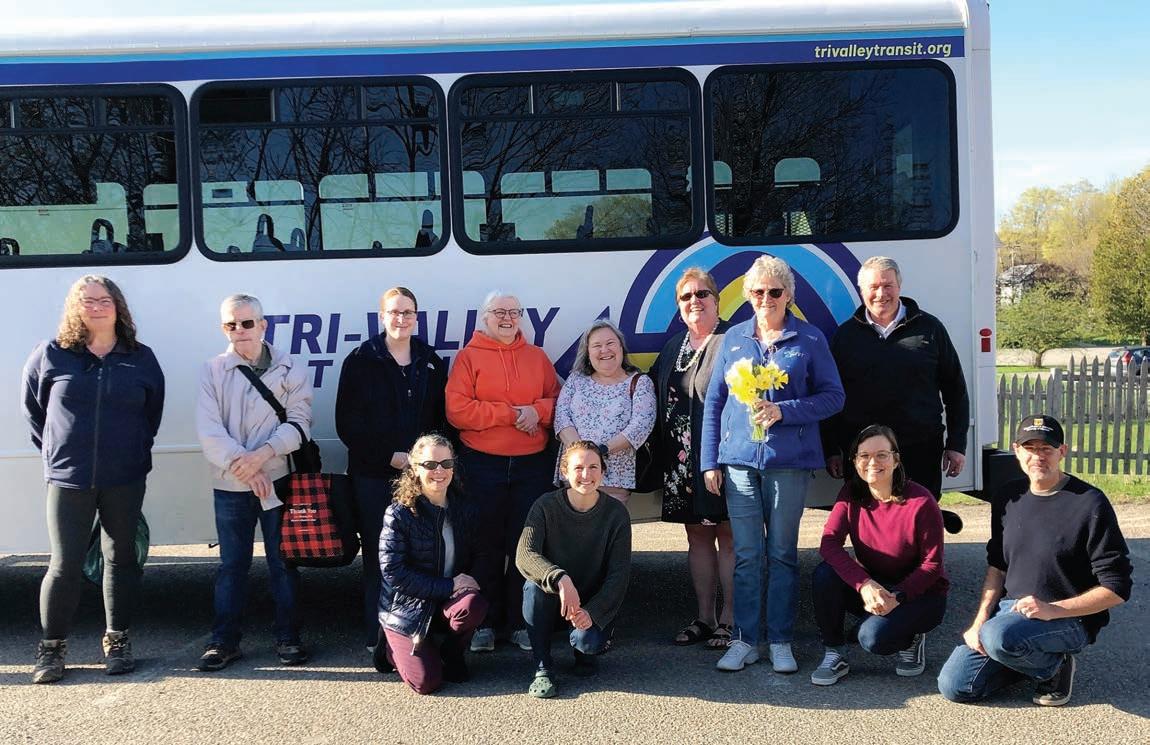
and both the drivers and frequent riders also tend to be friendly, recognizing and chatting regularly with each other. It is great to have both options.
Riding the commuter has become an
enjoyable part of Susan’s weekday. Many employers offer paid transit passes as a benefit for employees who don’t drive themselves or join a carpool, so it’s also a great way to save money when you have a regular work schedule.
The Tri-Valley Transit commuter bus runs later than when Susan gets out of work, so she usually takes the GMT bus instead. Or, when her father was in the hospital, she was able to visit him for an hour and pick up the commuter bus right at the medical center, its regular stop, at its regular time. The larger GMT buses are quieter with more space to stretch out,
Susan started riding the Tri-Valley Transit commuter because she didn’t have a car at her disposal, and because as a newer employee she wasn’t yet eligible for a parking pass. Now, it has become an enjoyable part of her weekday, so she doesn’t contemplate changing her commuting plans. Many employers offer paid transit passes as a benefit for employees who don’t drive themselves or join a carpool, so it’s also a great way to save money when you have a regular work schedule.
However, as Susan points out, there are so many other good reasons to join a commuter bus route, including getting to know others and having time to relax instead of driving. There are several other GMT commuter routes operating including the Milton Commuter, the St. Albans Link Express and the Montpelier Link Express.
The Special Services Transportation Agency is contracted by GMT to operate in some communities on a phone call or reservation-through-an-app dispatch basis for those who need affordable, fully
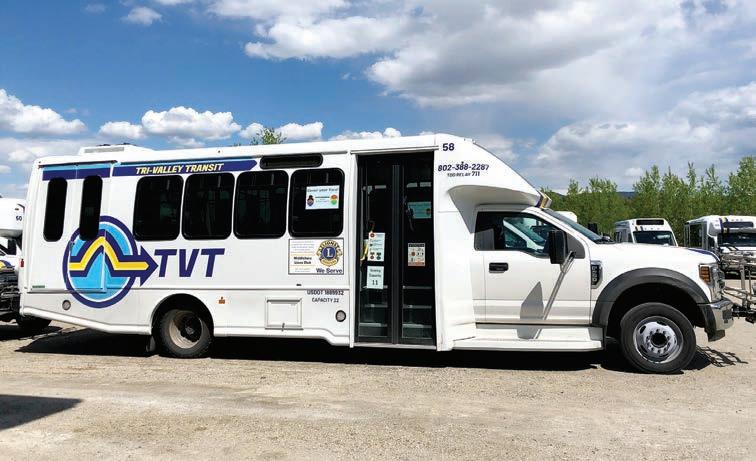
accessible transportation to appointments or shopping, among other things. This is referred to as micro-transit.
Some of these vehicles make scheduled trips to grocery stores and now even to South Burlington City Hall and library from senior living facilities in the area. What a wonderful way to support and provide autonomy for adults who are unable to get around on their own for whatever reason.
Here are important resources to check out so more of us can learn to be more independent and connected to our neighbors:
• Green Mountain Transit: ridegmt. com or 802-540-2468.
• Tri-Valley Transit: trivalleytransit.org or 802-388-2287.
• Special Services Transportation: for those 60 and up with an ADA defined
disability, 802-878-1527.
• South Burlington shopping shuttle: free weekly shuttles from senior housing to local supermarkets, 802-864-2282.
• Green Mountain Transit ADA Transportation: request an application at 802-540-0874 or email jposner@ridegmt. com for a guide.
Donna J. Leban, a licensed architect and lighting design consultant and member of the South Burlington Planning Commission, has owned a home in South Burlington for 30 years. Clean & Green is a regular feature, initiated and managed by the South Burlington Energy Committee, and will feature a variety of perspectives from members of city committees and commissions, city staff and outside organizations on environmental issues facing the city.

All riders must sign an annual waiver. Cyclists should sign up for each individual ride so ride leaders know how many people to expect.
For club rules and to join, visit gmbc.com.
Sunday, Aug. 4
Covered Bridges of Franklin and Lamoille County: Hilly 41-mile loop through Eden and Johnson, and 55-mile ride passes more covered bridges in Montgomery Center, returning through Bakersfield.
Meet at 8:45 a.m. at the Jeffersonville Fish and Wildlife Access, Route 108. The leader is Phyl Newbeck, 802-734-7016, vtphyl72@gmail.com
Saturday, Aug. 10
Gravel Grinder: Hollows, Ponds, and Falls.
Meet at 9:15 a.m. at Richmond Round Church across the street from Richmond Park area.
The leader is Brian Howard, 802-304-0610, bjhowd@gmail. com.
Sunday, Aug. 11
Venise En Quebec: Ride 40 miles from Alburgh across the border through farmland to Venise en Quebec, a summer resort on Missisquoi Bay. Lunch stop. ID required.
Meet at 9:45 a.m. at the Alburgh Community Education Center. The leader is John Bertelsen, 802-557-4633, jo.bertel@gmail.com.
Saturday, Aug. 17
Covered Bridges of Chittenden County: Gravel ride through
rolling hills of Shelburne and Charlotte with the longer ride going through Ferrisburgh.
Meet at 9:15 a.m. at Shelburne Community School. The leader is John Bertelsen, 802-557-4633, jo.bertel@gmail.com.
Sunday, Aug. 18
Waitsfield and Waterfalls: Enjoy a scenic tour through the countryside of Waitsfield and Warren with a visit to Moss Glen Falls south of Warren.
Meet at 9:15 a.m. at Waitsfield Elementary School. The leader is Allan Kunigis, 802-324-9958, akunigis@gmail.com.
Saturday, Aug. 24
Gravel Ride: Cambridge, Canyon and Bryce.
Meet at 9:15 a.m. at Underhill Central School. The leader is John Stuart, 802-734-9805, jhstuartsqn@gmail.com.
Sunday, Aug. 25
Buck Hollow and Beyond: 40-mile (route goes north to Fairfax, through Buck Hollow into Fairfield, returning via St. Albans. The 58-mile loop continues into Sheldon.
Meet at 8:45 a.m. at Milton High School. The leader is Dave Merchant, 802-825-3808, merchand59@gmail.com.

FARMING continued from page 1
farm infrastructure.
There is no surprise that the nature of farming is shifting. In addition to the daily, labor-intensive work — most work from sunup to sundown — farmers must also adapt to a changing climate and unpredictable weather events, increasing infrastructure costs and a housing crisis that leaves many workers earning low wages without a place to live.
“We understand that there are absolutely critical issues that we are currently facing in our farming community,” Brie Gelinas, co-director of the new nonprofit, said. “We’re talking about the foundation of what Vermont is. Vermont is not Vermont without farms, and even though there’s a lot of land and there’s a lot of abundance, what’s happening is that land is becoming increasingly unaffordable to a farmer. There’s also a challenge with affordable infrastructure, and that’s due to the soaring equipment costs. We also have a challenge with the retention of the workforce, and that’s because there is this housing crisis and, obviously, inflation just exacerbates an already very huge problem.”
The idea of the collective is relatively simple, she said. If farms pool their resources, the rate of survival is inherently higher.
The nonprofit’s founders — whose farms sit within a one-mile radius of each other — collectively provide fresh fruits, vegetables, meat, poultry, eggs and value-added products to over 13,500 customers. They feed more than 450 households weekly with organic produce through commu-



nity supported agriculture, or CSA, and offer food and land education programs and 150-plus events each year.
The larger vision for the new farm began in 2017 when Bread and Butter Farm, spearheaded by owner Corie Peirce, saw a “for sale sign” posted on the old Auclair Farm almost directly across the street from her farm, which straddles the South Burlington and Shelburne town line just off Cheesefactory Road.
“When we saw the for-sale sign posted on the Auclair Farm, we immediately acted to find a way to protect its place as an open landscape and working farm in our community. We approached the city of South Burlington and received an overwhelmingly positive response to pursue a conservation path for this land,” the farmers wrote in 2018.
The city fronted nearly $605,000 in open space money to help in the conservation of portions of the land with the Vermont Land Trust, which currently owns the land.
“We’ve partnered with them, we’ve conserved the land, brought the cost of the land down, and now we need to finalize that,” Gelinas, who joined the nonprofit team last year, said. “The final step is to purchase those 360 acres from them.”
Abby White, vice president for engagement at the Vermont Land Trust, said her team has been
See FARMING on page 13
The Outside Story
Rachel Sargeant Mirus
A long time ago, not so far away, freshwater plants partnered with fungi and moved onto land from lake and river shores. Since that time, land plants have evolved many sophisticated strategies for terrestrial life. Yet to this day, growing in damp forests and on foggy mountainsides, there are plants that embody ancient botanical history.
Liverworts are the closest living analogs to the first plants that arrived on land, almost half a billion years ago. These primitive plants lack structures to control water loss, are very small, and grow mostly in damp habitats. There are two main types: thallose liverworts, which grow as leathery green patches on bare soil and on rocks in streams, and leafy liverworts, many of which superficially resemble mosses.
One example of a leafy liverwort is the rare Hooker’s flapwort (Haplomitrium hookeri). In New England, this species’ only known habitat is on Mt. Washington, where it grows on wet, north-facing rocks in Tuckerman Ravine. It’s a stubby, bright green plant, about a millimeter tall. Jeff Duckett, emeritus professor of botany working at the Natural History Museum, London, has observed Haplomitrium on six continents. “If you have a trained eye, it can immediately be recognized by its distinct bright green color, even though it’s very small,” he said.
Duckett’s research on Hooker’s flapwort has made important contributions to the study of plant evolution. Scientists already recognized that liverworts — like most other land plants — have relationships with Glomeromycotina, a group of mycorrhizal fungi that form branched structures inside the root cells of their host plants. These “gloms” help the plants access phosphorus and nitrogen in the soil in exchange for carbohydrates.
But Duckett and collaborators discovered a relationship between liverworts and a previously overlooked group of fungi that may have played an essential role in plants’ colonization of land.
Like other leafy liverworts, Hooker’s flap-


wort grows as a network of underground axes, or stem-like structures, that put out small, photosynthesizing shoots above the soil.
Looking at these subterranean stems using an electron microscope, Duckett noticed a
symbiotic fungus that he described as an “odd fungus that looked like nothing anyone had seen before.”
Duckett was curious about the fungus, so he teamed up with Martin Bidartondo, a


molecular ecologist working at Kew Gardens. Initially Bidartondo was at a loss, reporting back that he couldn’t identify the fungus’s DNA. Eventually, using new techniques, he found that the mystery symbiont belonged to the Mucoromycotina, or “mucs,” an ancient lineage of fungi previously known only as free-living decomposers.
Mucs can form a variety of structures inside their host plant’s cells but have finer hyphae than the gloms. Work by Katie Field at Sheffield University, Silvia Pressel, senior researcher at the Natural History Museum in London, and one of her students, William Rimington, showed that Hooker’s flapwort was indeed gaining phosphorus and nitrogen from the mucs species, and giving carbon in return. Since that discovery, they have found that mucs form symbiotic relationships with numerous other plants, including some crop species, and often coexist with gloms.
These discoveries have prompted many new questions about plant evolution that researchers have yet to answer. How do plants, gloms, and mucs work together to balance each partners’ nutritional needs? Do mucs share unique benefits with their partners, such as access to more nitrogen through their role as decomposers? How did each of these fungal relationships offer plants different advantages as they moved onto land?
These questions are so wide ranging and interconnected that no one person has all the expertise to answer them. “This is why science today is teamwork,” Duckett said. They’re also fun questions to ponder, as you walk through the woods this summer. When you notice green patches on rocks in a stream, or if you spy a patch of stubby plants during a hike in Tuckerman Ravine, pause for a moment. You’re in the presence of ancients, and a venerable, still mysterious partnership that carried life from the water.
Rachel Sargent Mirus is a teaching artist and writer. Illustration by Adelaide Murphy Tyrol. The Outside Story is assigned and edited by Northern Woodlands magazine and sponsored by the Wellborn Ecology Fund of the New Hampshire Charitable Foundation, nhcf.org.










continued from page 1
quarters on Queen City Park Road to a 1,500-person concert venue in collaboration with Higher Ground — nearly 400 more people than can be accommodated at the nightclub’s current location on Williston Road in South Burlington.
The music venue is just one part of a greater vision to create a mixed-use entertainment “hub” space on the Burton campus. The company originally received approval from the Burlington Development Review Board in September 2020 and two years later received state approval from the Act 250 commission.
But a resident group, Citizens for Responsible Zoning, appealed both decisions in environmental court, saying traffic, noise and overall aesthetic impacts would cause undue problems for abutting neighbors in Burlington and South Burlington.
When Vermont Superior Court Judge Mary Miles Teachout ruled in favor of Burton and Higher Ground last year, the group again appealed the decision — with the support of the city of South Burlington, which signed on as an interested party — to the state’s highest court, saying the lower court erred in its findings regarding the sale and consumption of alcohol, the city’s own noise ordinance and adverse traffic impacts.
The issues intensified last summer when nearly two dozen residents living near Queen City Park were issued no-trespass notices by the Burton Corporation,
continued from page 11
collaborating with the collective, and has even helped fundraising efforts for Agrihood to eventually purchase the 360 acres.
“If we want to be successful in protecting land, particularly farmland, we have to ensure that the farmers who are working that land are also successful,” she said. “What’s really exciting about The Agrihood Collective is that it is an innovative way for farmers to come together and figure out how to be economically viable on the land.”
A massive win came when the collective received a recent donation of just under $1 million to purchase a 13-acre stretch of developable land just north of the property from the nonprofit Dirt Capitals Partners.
By the end of the month, the transaction should be signed, sealed and delivered, Gelinas said.
That is where the group envisions a commercial kitchen, freezer refrigeration, shared farming equipment and a possible event space. More important, it is where the collective plans to build hous-
who believed residents involved in the litigation were interfering with business operations and spreading misinformation.
Despite the higher court’s ruling last week, residents may not have given up the fight yet, according to James Dumont, lawyer for the citizens’ group.
“We
“We still have grave concerns about noise and traffic from a 1,500-seat venue serving alcohol whose patrons will pour out into our residential neighborhoods and get into their cars, trucks and motorcycles after midnight and sometimes after 2 a.m.,” the group wrote.
tion of 12 events per year that can run until 2 a.m.; and Burton must install a permanent noise monitoring station at its property line to enforce World Health Organization noise limits.
still have grave
concerns about noise and traffic from a 1,500-seat venue serving alcohol.”
But the group said now the project enters an entirely different legal landscape — the permitting process for an entertainment permit and a liquor license.
— Citizens
According to the statement, while the group is disappointed in the Supreme Court ruling, they were grateful for some wins that have been granted throughout the legal process.
They thanked the district commission and Teachout who, in addition to her denial, added additional operating stipulations for Burton and Higher Ground, which now must coordinate efforts with South Burlington and Burlington police to ensure parking doesn’t overflow into surrounding neighborhoods; ensure ticketed events end by midnight, with the excep-
“Here, the decision maker is the City Council, which by law has broad discretion to address our concerns in a way that the zoning board, the District Commission and Judge Teachout could not,” they wrote. “We plan to address these issues when Higher Ground applies for its entertainment permit and liquor license.”
“We also are hoping that Burton, as a ‘Certified B Corporation,’ will ultimately be respectful of their neighbors’ right to peaceful enjoyment of their property and uninterrupted sleep,” they wrote.
A spokesperson for Higher Ground did not return a request for comment, but Sonya Sibold, vice president and general counsel at Burton, said in a statement, “We are pleased with the decision of the Vermont Supreme Court and are happy to put this issue to rest.”
Interested in a gig that takes just four to five hours a week?
Deliver The Other Paper of South Burlington, Shelburne News and The Citizen to vendors around Chittenden County.
Thursday afternoons and/or Friday mornings. Hourly wage plus mileage.
Send a letter of interest to bryan@newsandcitizen.com or call (802) 253-2101.




Academic
•Educational Coordinator
Special Education Teachers
•Academic Case Managers
• Certi ed Classroom Teachers
ing that’s affordable for its workers.
Of the $750,000 needed to buy the separate 360-acre property, the collective has already raised nearly $435,000. But receiving the $1 million donation for the 13 acres sent a much-needed message of support to the team.
“Receiving that donation was a huge movement in the right direction, and helped us to really go, ‘OK, this something that can work, this is something that people believe in,’” Gelinas said.
“It’s not just us on the inner circle that are hopeful and wishing for this to exist.”
City council members in South Burlington attended an event at Bread and Butter Farms last month that focused on the Agrihood Collective and they showed overwhelming support for the project at a council meeting in July.
“I’m very proud of the city’s role in that it helped conserve those 400 acres,” city councilor Andrew Chalnick said. “Lots of excitement there about the conservation, about what they’re doing
on the land, and the regenerative agriculture, and just how important that local food production is to South Burlington, Chittenden County and the state of Vermont.”
Gelinas anticipates that as the nonprofit moves into a new phase of more public fundraising efforts, events across all the farms like the one last month will pop-up in coming months. The “community conversations,” as they refer to them, are to grow increasing support from community members while looking for continued donations to purchase the land this year.
“This is such a critical moment for farming in Vermont, which is such a farm state,” she said. “It’s really the core fabric of what ties the community together. It’s what has been so part of the history of Vermont, as well as the economics. So, I think people deeply care about farming. They really care about the land, and they’re also seeing that there are some things that need to evolve so that we can support the farmers in the right ways.”
Residential
•Community Leaders
•Youth Counselors
•Awake Overnight Counselors
•Transporters
•Cleaning Sta
•Maintenance Sta
Leadership
•Assistant Program Director
•Mental Health Clinicians
•HR Coordinator
•Nurse
Our Trauma-Informed program o ers supportive living environments designed to change the lives of youths and families struggling with signi cant mental and behavioral health issues.
The academic sta will employ innovative strategies to help nontraditional students learn while being supported by trained mental health professionals. We o er academic support services for individualized learning and our students will have access to the general education curriculum, as outlined by the Vermont Agency of Education.
For more information please contact Tina Robinson at 603-960-4487 or email tr.humanresources@MPA.US























Last year, Vermonters threw away 71,113 tons of food scraps which ended up in our only landfill. Equal to 242 pounds of food scraps per person per year.
CSWD’s Organic Recycling Facility (ORF) and our six Drop-Off Centers accept food scraps from residents and businesses to keep them out of Vermont’s only landfill.











